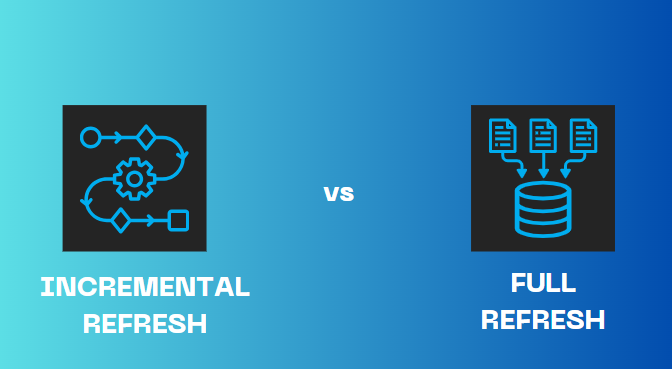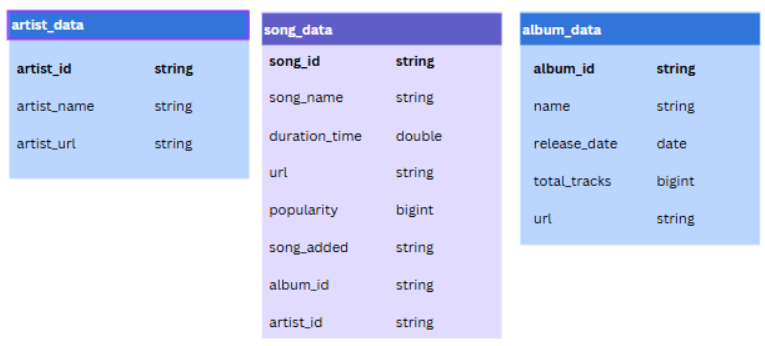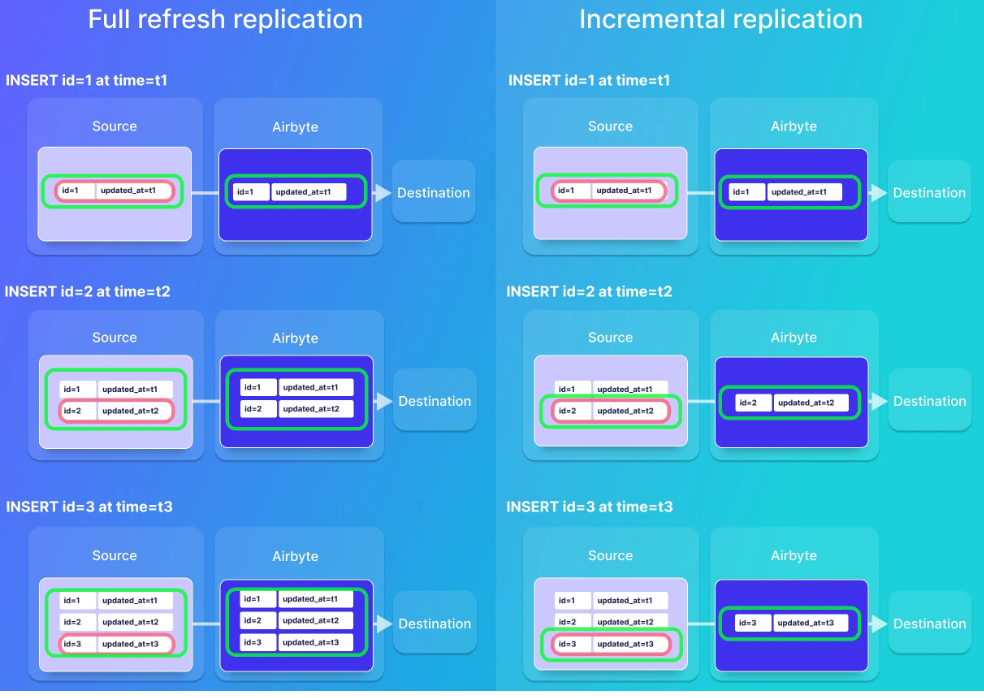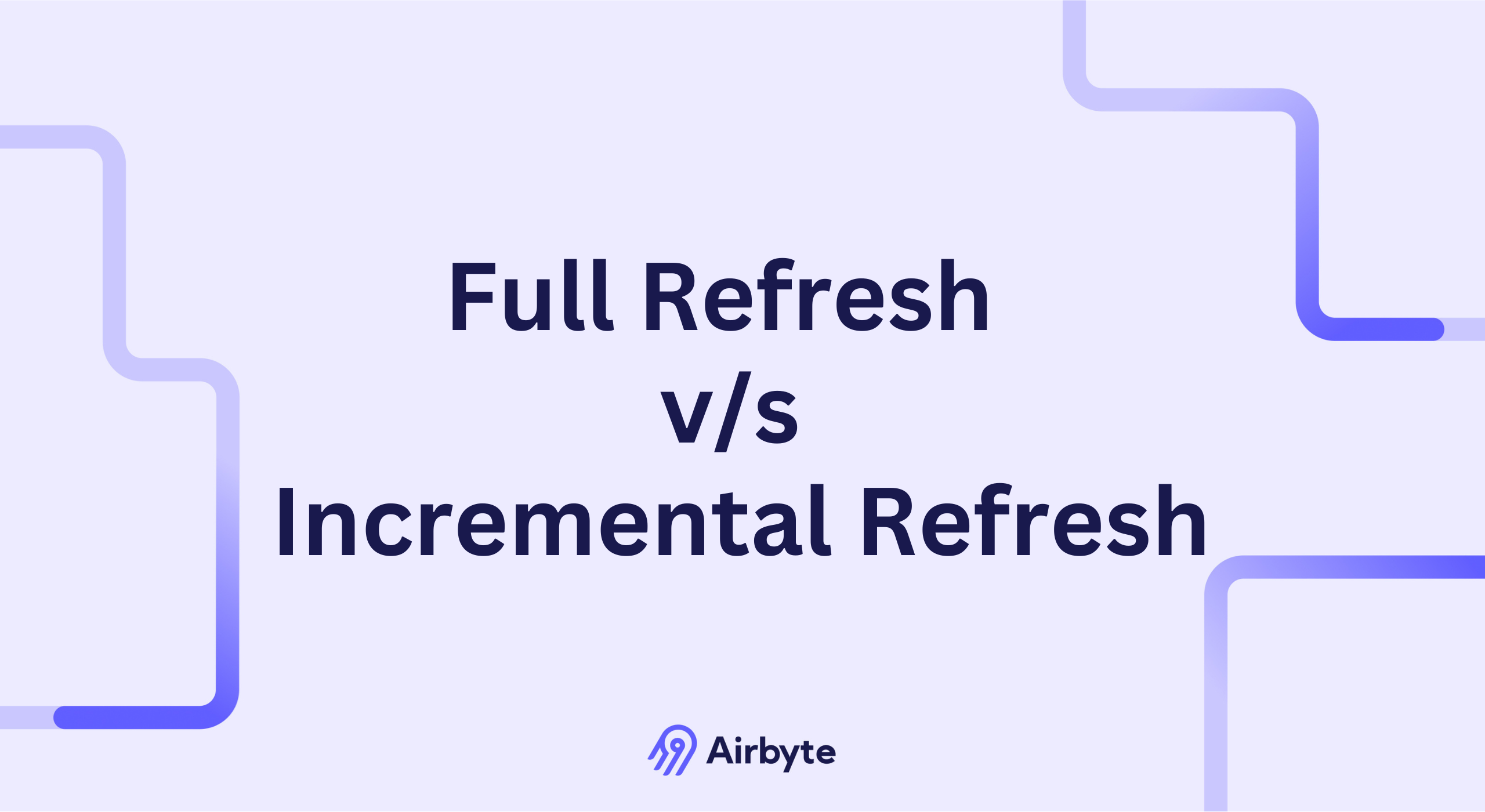Full Refresh vs Incremental Refresh in ETL: How to Decide?
Summarize this article with:
✨ AI Generated Summary
ETL refresh strategies include full refresh, which reloads entire datasets ensuring data consistency but is resource-intensive, and incremental refresh, which updates only new or changed data, optimizing performance and cost for large or frequently updated datasets. Change Data Capture (CDC) enhances incremental refresh by capturing real-time data changes, while hybrid strategies combine both methods to balance efficiency and reliability across data tiers. Key considerations for choosing a strategy involve data volume, update frequency, resource constraints, and business needs, with modern tools like Airbyte supporting flexible, scalable implementations.
ETL (Extract, Transform, Load) tools are essential for modern organizational data management. These tools enable you to integrate large datasets with ease while minimizing the need for extensive manual intervention. However, to fully optimize your ETL process, it's important to determine the best method to load data from source to destination.
If you want to reload everything from scratch, a full load is the suitable choice. An incremental refresh is well-suited when you need to focus only on new or updated data.
This article explains how full refresh vs. incremental refresh work, when to implement each approach, and where they are used in the real world.
What Are the Core Differences Between Data Refresh Strategies?
A data-refresh strategy updates or replaces the existing data in the target system with the latest data from a source. The two most common strategies are full refresh and incremental refresh:
- Full refresh replaces the entire data set.
- Incremental refresh updates only new or changed records.
Choosing the right strategy affects performance, cost, and data-quality outcomes and can help optimize large data-volume deployments. Understanding the distinction between operational data store (ODS) load vs refresh patterns becomes crucial when architecting modern data pipelines, as each serves different analytical and operational needs.

How Does Full Refresh Work in Modern Data Pipelines?
A full refresh reloads or replaces all of the data in the target system with the latest data from the source. Because the target table is typically truncated before loading, this is sometimes called a destructive load.
When to Use Full Refresh
- Complete data-accuracy requirements: When every record must exactly match the source.
- Small data volumes: Minimizes processing time and resource usage.
- Simple source systems: Few dependencies reduce complexity and risk.
- Infrequent updates: Reloads are tolerable because they happen rarely.
Advantages
- Data consistency: Eliminates discrepancies between source and target.
- Simple implementation: No need for complex change-tracking logic.
- Reliable audit trails: Clear timestamps mark each full load.
- Error recovery: Resets the target to a known-good state.
Disadvantages
- Resource-intensive: Consumes more CPU, memory, and storage.
- Extended processing time: Especially for large datasets.
- Increased network load: Large data transfers can congest the network.
What Makes Incremental Refresh Effective for Large Datasets?
An incremental refresh loads only the records that are new or have been updated since the last load, greatly reducing the amount of data processed. Most implementations rely on time-based or change-data-capture logic to identify deltas.
When to Choose Incremental Refresh
- Large data volumes: Minimizes the data moved during each run.
- Frequent updates: Avoids redundant reloads.
- Resource constraints: Lowers compute and storage requirements.
- Real-time or near-real-time needs: Provides fresher data faster.
Advantages
- Faster processing: Only the delta is handled.
- Lower costs: Reduced compute, storage, and bandwidth.
- Reduced network load: Smaller payloads, better performance.
Disadvantages
- Complex implementation: Requires reliable change detection.
- Potential inconsistencies: Errors can affect only part of the dataset.
- Change-tracking requirement: Additional metadata or CDC tooling.
- Complex error handling: Issues can be harder to diagnose.
How Do Full Refresh and Incremental Refresh Compare?
Full Refresh reloads the entire dataset; Incremental Refresh updates only new or changed data.
What Are the Best Practices for Technical Implementation?
Full Refresh Implementation
- Define the target table: Ensure source and target schemas align.
- Extract data: Via SQL, API, file, etc.
- Transform data: Convert formats and apply business rules.
- Delete existing data:
TRUNCATEorDELETEthe target table. - Load data: Insert the transformed records.
Python Code Snippet:
Incremental Refresh Implementation
- Define target-table schema: Same as full refresh.
- Delta identification: Detect changed data via last-updated timestamps and control tables that store the last successful extraction time
- Watermark management: Store the last processed timestamp or ID.
- Handle late-arriving data: Reconcile out-of-order changes with CDC, reconciliation jobs, or data-quality checks.
What Role Does Change Data Capture Play in Modern Refresh Strategies?
Change Data Capture (CDC) has emerged as a fundamental technology for enabling sophisticated incremental refresh strategies. CDC provides real-time identification of data changes by monitoring database transaction logs, making it possible to capture inserts, updates, and deletions with minimal impact on source systems.
Log-Based CDC Implementation
Log-based CDC represents the most advanced approach to change detection. This method parses database transaction logs to identify changes without requiring triggers or additional processing overhead on source systems. Modern platforms like Apache Kafka with Debezium connectors enable organizations to build event-driven architectures where data changes flow as continuous streams.
The key advantage of log-based CDC lies in its ability to capture deletions, which traditional timestamp-based incremental approaches often miss. When a record is deleted from the source system, log-based CDC can propagate this change to downstream systems, maintaining data consistency across the entire pipeline.
CDC Integration Patterns
Implementing CDC requires careful consideration of schema evolution and message ordering. Advanced CDC implementations use techniques like slowly changing dimensions (SCD) to preserve historical context while maintaining current state views. Type 2 SCD patterns, for example, maintain version history by creating new records for changes rather than overwriting existing data.
Modern data integration platforms increasingly support hybrid CDC approaches that combine real-time change streams with periodic reconciliation processes. This pattern ensures that any missed changes or system outages don't compromise data integrity while maintaining near-real-time data freshness.
Technical Considerations for CDC
CDC implementations must address several technical challenges, including schema drift, message ordering, and handling of large transactions. Successful deployments typically implement dead letter queues for handling failed messages, schema registries for managing evolving data structures, and idempotent processing to handle message replay scenarios.
The choice between trigger-based CDC and log-based CDC depends on factors including source system constraints, data volume, and latency requirements. While trigger-based approaches offer simpler implementation, log-based solutions provide better performance and reduced source system impact for high-volume environments.
How Do Hybrid Refresh Strategies Optimize Performance and Cost?
Hybrid refresh strategies combine the reliability of full refresh with the efficiency of incremental approaches, creating optimized solutions for complex data environments. These strategies recognize that different data types and usage patterns within the same organization may require different refresh approaches.
Tiered Storage and Refresh Patterns
Modern hybrid implementations often use tiered storage architectures where recent, frequently accessed data receives incremental updates while historical data undergoes periodic full refreshes. This approach optimizes resource utilization by applying intensive processing only where it provides the most value.
Hot tier data, typically covering the most recent months, receives frequent incremental updates to support real-time analytics and operational reporting. Warm tier data, covering intermediate time periods, may receive weekly incremental refreshes to balance freshness with resource consumption. Cold tier data, representing long-term historical information, undergoes full refreshes on monthly or quarterly schedules to ensure data integrity without excessive resource usage.
Dynamic Refresh Selection
Advanced hybrid strategies implement intelligent refresh selection based on data characteristics and usage patterns. Machine learning models can analyze factors including data volume changes, query patterns, and historical error rates to automatically determine optimal refresh strategies for different datasets.
These systems monitor data change rates and automatically switch between full and incremental refresh modes based on efficiency thresholds. When incremental processing becomes more resource-intensive than full refresh due to high change volumes, the system automatically transitions to full refresh mode for that specific dataset.
Resource Optimization Frameworks
Hybrid approaches excel at cost optimization by aligning refresh frequency with business value. Critical operational data receives real-time incremental updates, while analytical datasets may use scheduled batch processing during off-peak hours to minimize resource costs.
Cloud-native implementations leverage auto-scaling capabilities to provision resources dynamically based on refresh requirements. This approach ensures that full refresh operations receive adequate resources without maintaining expensive infrastructure for routine incremental processing.
Modern platforms implement cost-aware scheduling that considers factors including cloud provider pricing models, data center carbon footprint, and business-critical periods when optimizing refresh schedules across hybrid architectures.
How Can You Learn From Real-World Implementation Examples?
1. Financial Transaction Processing — Uber
Uber's drivers may receive tips hours after a trip, producing late-arriving data.
- Challenge: Traditional ETL needed to reprocess months of data.
- Solution: Apache Hudi incremental processing with Spark and Piper.

Results:
- 50% reduction in pipeline runtime
- 60% improvement in SLA adherence
- Eliminated constant reprocessing of old data
2. Weekly Analytics Pipeline — Spotify
- Goal: Keep a Discover Weekly playlist dataset current.
- Strategy: Full refresh once per week.
- Stack: AWS Lambda, S3, Secrets Manager, Glue, Athena.

Results:
- Fully automated weekly refresh
- Data always available in S3 for analysis
- Serverless architecture keeps costs low
How Does Airbyte Support Your ETL Refresh Strategy?

Whether you choose incremental or full refresh, Airbyte provides reliable, scalable data integration with both ELT and ETL options. Airbyte's open-source foundation eliminates vendor lock-in while providing enterprise-grade security and governance capabilities.
Airbyte offers flexible sync modes so you can choose how data is read and written:

- Incremental Append: New/updated records
- Incremental Append + Deduped: Plus a de-duplicated view
- Full Refresh Append: Reload without deleting existing data
- Full Refresh Overwrite: Reload and overwrite the destination
Enterprise-Grade Capabilities
Airbyte processes over 2 petabytes of data daily across customer deployments, supporting organizations from fast-growing startups to Fortune 500 enterprises. The platform offers multiple deployment options, including fully-managed cloud service, self-managed enterprise solutions, and open-source community editions.
Advanced features include end-to-end data encryption, role-based access control integration with enterprise identity systems, comprehensive audit logging, and SOC 2, GDPR, and HIPAA compliance for regulated industries. The platform's Kubernetes support provides high availability and disaster recovery capabilities while automatically scaling with workload demands.
What Should You Consider When Choosing Your Refresh Strategy?
Full and incremental refresh strategies are critical for moving data accurately from source to destination. The key difference lies in how data is synchronized: full refresh reloads everything, whereas incremental refresh updates only what changed. Selecting the right approach for your workload improves efficiency, cost, and performance.
Modern implementations increasingly favor hybrid approaches that combine the reliability of full refresh with the efficiency of incremental strategies. Consider factors including data volume, change frequency, resource constraints, and business requirements when designing your refresh strategy.
Frequently Asked Questions
1. How do I handle deletions in incremental refresh scenarios?
Deletions pose a significant challenge in incremental refresh since standard timestamp-based approaches can't detect removed records. Solutions include implementing soft deletes with status flags, using Change Data Capture (CDC) to monitor database logs for DELETE operations, or combining incremental refresh with periodic full refresh reconciliation to catch any missed deletions.
2. What happens when incremental refresh fails partway through?
If an incremental refresh fails mid-process, only data up to the last successful checkpoint is retained. After fixing the issue, rerun the refresh — ideally with idempotent logic, checkpoint recovery, and retries — to safely backfill missing or partial data.
3. How can I optimize refresh performance for very large datasets?
Large dataset optimization strategies include implementing parallel processing by partitioning data across multiple workers, using compression and efficient data formats like Parquet, leveraging cloud-native auto-scaling capabilities, implementing tiered storage strategies that separate hot and cold data, and choosing appropriate refresh schedules that balance freshness requirements with resource availability.
4. When should I consider switching from full refresh to incremental refresh?
Switch to incremental refresh when data volumes are large, growth is continuous, and only a small portion changes between loads. It reduces compute, storage, and network overhead—ideal once full refreshes exceed time, cost, or bandwidth limits for production use.
5. How do I maintain data quality with incremental refresh strategies?
Maintaining data quality in incremental refreshes requires schema validation, record-level reconciliation, and anomaly detection. Use checkpoints and metadata tracking to ensure continuity, automate audits to compare deltas with source data, and monitor trends to catch drift or corruption early.

.webp)
